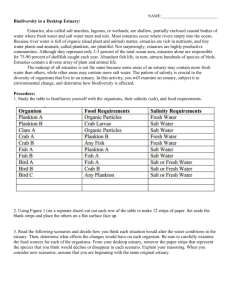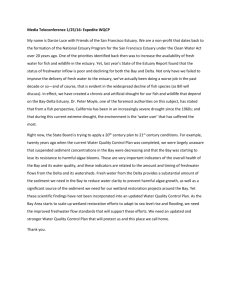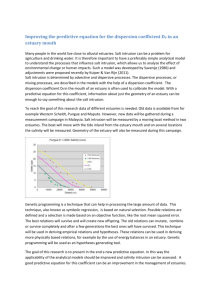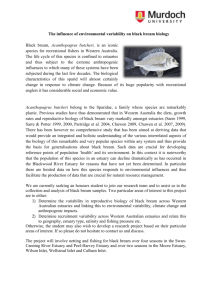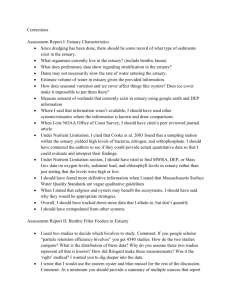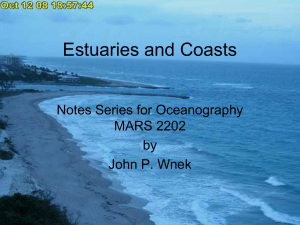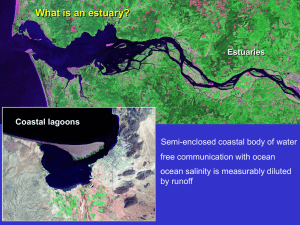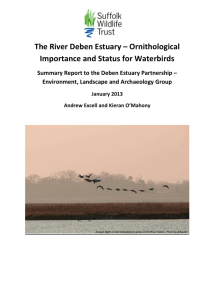Envirothon 2011 oral presentation problem scenario
advertisement
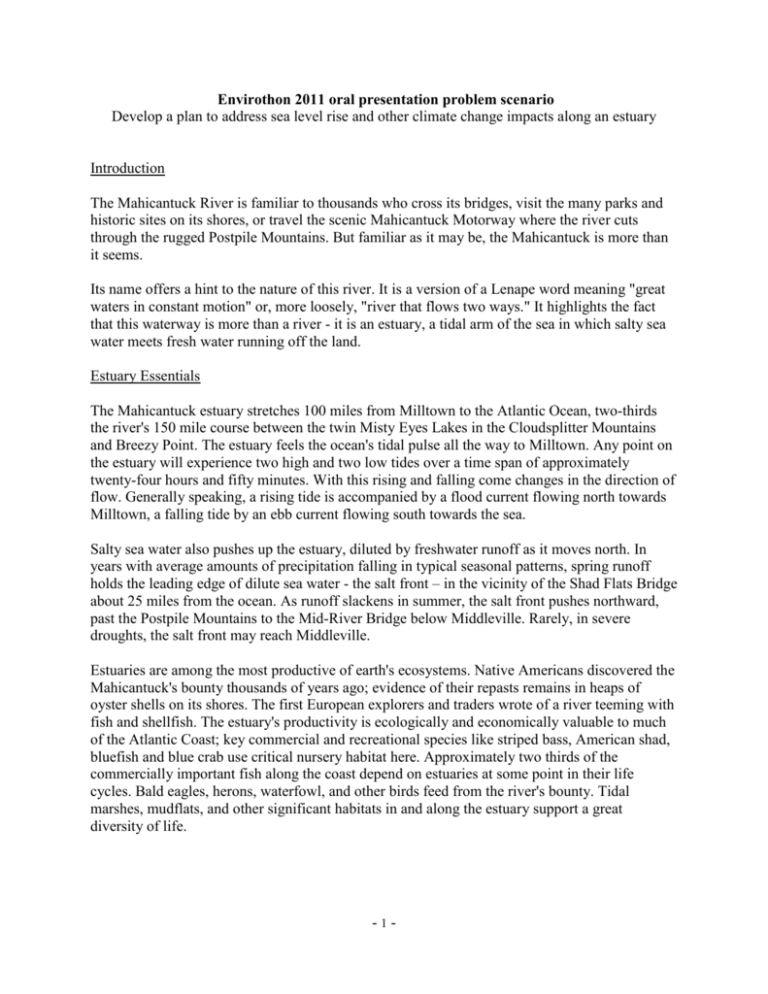
Envirothon 2011 oral presentation problem scenario Develop a plan to address sea level rise and other climate change impacts along an estuary Introduction The Mahicantuck River is familiar to thousands who cross its bridges, visit the many parks and historic sites on its shores, or travel the scenic Mahicantuck Motorway where the river cuts through the rugged Postpile Mountains. But familiar as it may be, the Mahicantuck is more than it seems. Its name offers a hint to the nature of this river. It is a version of a Lenape word meaning "great waters in constant motion" or, more loosely, "river that flows two ways." It highlights the fact that this waterway is more than a river - it is an estuary, a tidal arm of the sea in which salty sea water meets fresh water running off the land. Estuary Essentials The Mahicantuck estuary stretches 100 miles from Milltown to the Atlantic Ocean, two-thirds the river's 150 mile course between the twin Misty Eyes Lakes in the Cloudsplitter Mountains and Breezy Point. The estuary feels the ocean's tidal pulse all the way to Milltown. Any point on the estuary will experience two high and two low tides over a time span of approximately twenty-four hours and fifty minutes. With this rising and falling come changes in the direction of flow. Generally speaking, a rising tide is accompanied by a flood current flowing north towards Milltown, a falling tide by an ebb current flowing south towards the sea. Salty sea water also pushes up the estuary, diluted by freshwater runoff as it moves north. In years with average amounts of precipitation falling in typical seasonal patterns, spring runoff holds the leading edge of dilute sea water - the salt front – in the vicinity of the Shad Flats Bridge about 25 miles from the ocean. As runoff slackens in summer, the salt front pushes northward, past the Postpile Mountains to the Mid-River Bridge below Middleville. Rarely, in severe droughts, the salt front may reach Middleville. Estuaries are among the most productive of earth's ecosystems. Native Americans discovered the Mahicantuck's bounty thousands of years ago; evidence of their repasts remains in heaps of oyster shells on its shores. The first European explorers and traders wrote of a river teeming with fish and shellfish. The estuary's productivity is ecologically and economically valuable to much of the Atlantic Coast; key commercial and recreational species like striped bass, American shad, bluefish and blue crab use critical nursery habitat here. Approximately two thirds of the commercially important fish along the coast depend on estuaries at some point in their life cycles. Bald eagles, herons, waterfowl, and other birds feed from the river's bounty. Tidal marshes, mudflats, and other significant habitats in and along the estuary support a great diversity of life. -1- The region's human inhabitants have also flourished thanks to the river. The Mahicantuck is a source of drinking water, food, and recreation. Its renowned scenery, including the water gap through the Postpile Mountains, attracts tourists and artists. Environmental Implications of Living on an Arm of the Sea People living in Milltown, Middleville, and other cities along the Mahicantuck estuary care about the water quality and ecological health of this waterway. The river has been spared some of the abuse visited on other Atlantic Coast estuaries like the Hudson River, New York Harbor, Delaware Bay, and Chesapeake Bay. But now they are learning that, while they have taken measures to protect the Mahicantuck from pollution, they must cope with additional issues facing these other estuaries. An estuary exists at the border between its watershed and the ocean. As a result, problems that affect an estuary may have their sources not in the estuary itself but in the ocean or the watershed. For example, the American shad – a valuable catch for the Mahicantuck’s commercial fisherman – has been declining in numbers. It’s quite likely that this decline is mainly due to hazards encountered during the time the fish spends in the ocean rather than the relatively brief portion of its life cycle spent in the estuary. Like the striped bass and Atlantic sturgeon, the shad is anadromous; it is born in fresh water but soon swims out to sea where it will spend most of its life, returning to the Mahicantuck only to spawn. While in the ocean the shad faces dangers ranging from predation to nets. This connection to the ocean presents the towns and cities along the Mahicantuck with a new environmental threat. Due to climate change, rising sea levels are beginning to impact their waterfronts, since the water’s height in the estuary is nearly at sea level all the way to the head of tide in Milltown. When nor’easters and other storms batter the coast, storm surges travel up the Mahicantuck. In recent years, parks, private yards, and highways – including the low-lying Mahicantuck Motorway – have been inundated by storm surge flooding. There are also concerns that flooding might damage sewage treatment infrastructure in the valley; many of the pump stations and treatment plants are right along the river. With sea level conservatively predicted to rise 7 to 23 inches by the end of the century, and perhaps as much as four and a half feet, flooding is likely to get worse in riverfront communities. Middleville, the largest city on the estuary, has another climate change concern. The city draws its drinking water from the Mahicantuck, and has for many decades. In the past, engineers have rarely had to deal with salt water entering the system. The salt front reached upriver to Middleville only in the most severe droughts, when little fresh water was running off the watershed to hold the seawater back. However, as sea level rises, the point at which fresh water and salt water meet may shift further upstream. And while climate change in the Northeastern U.S. is predicted to increase precipitation overall, it will occur in fewer but more intense events, creating a scenario of alternating droughts and severe storms. The droughts might make saltwater intrusion to Middleville more common in the future. Even very diluted as it is at the salt front, seawater in drinking water could be a health issue for Middleville residents on low-salt diets. -2- The impacts of climate change and rising sea levels also will be felt in the habitats of the Mahicantuck River estuary, especially the extensive salt marshes at the river’s mouth. In New York State, the acreage of tidal wetlands associated with estuaries is declining. Much of what remains is shifting from high marsh, the cattails and reed beds that are periodically flooded at high tide, to low marsh and mudflats that are regularly underwater at high tide. These wetlands and marshes are important to people and fish and wildlife. They form a natural buffer to storm damage, provide spawning grounds, nurseries, shelter, and food for finfish, shellfish, birds and other wildlife, and can improve water quality by filtering, storing, and detoxifying wastes. Although many factors are involved in tidal wetland loss, sea level rise will make the problem worse. The physical disruption of waves and flooding associated with storms undermines the integrity of marshes. It’s probable that storm surges superimposed on higher sea levels will increase the frequency and extent of flooding in these habitats, increasing the risk of damage. As sea levels rise and the lowest portions of marshes become permanently submerged, these wetland communities may be able to migrate landward. However, this might not be possible if the wetlands are bordered by dense development, seawalls and bulkheads, or steep slopes. Beds of submerged aquatic vegetation [SAV] - flowering plants that grow underwater – are an especially significant habitat in estuaries like the Mahicantuck. They regulate water flow, stabilize sediments, produce food for marine life, and replenish dissolved oxygen in the surrounding waters. SAV provides critical nursery grounds for wading birds and waterfowl and for commercially, recreationally, and ecologically important fish and shellfish. In 1930, there were an estimated 200,000 acres of these beds in New York State. This area has decreased by almost 90 percent over time to 21,803 acres. While most of this loss is associated with water pollution, fishing and boating, sea level rise and climate‐driven temperature change are also beginning to threaten SAV. As the water becomes deeper, less sunlight penetrates down to these rooted plants. While SAV beds might move shoreward into shallower water, manmade structures placed to protect shores could prevent that migration. While research hasn’t yet been done on the Mahicantuck, data from fisheries surveys indicate that Atlantic tomcod and rainbow smelt are declining in the nearby Hudson. Both species are fish of cold waters; rising water temperatures in the Hudson are correlated with their declines. Even the American eel – while still a common catch – is not present in the numbers it once was. This decline, observed throughout the eel’s range, may be the result of climate change and its effects on ocean currents that bring young eels from their birthplace in the Sargasso Sea to estuaries like the Mahicantuck. The Scenario: Planning to Address Climate Change Impacts on the Estuary The members of your group have been appointed to serve on the Mahicantuck Environmental Leadership Team [MELT] with a charge to come up with a plan for addressing higher water levels, increased flooding, and other impacts of climate change. Your plan must go through an environmental review that will involve public hearings to encourage comment from interested citizens, businesses, advocacy groups, local governments and state agencies. -3- The communities of the Mahicantuck are aware of the problems associated with climate change and sea level rise. There has been debate about the best way to address the issues. Some citizens want to focus on working with nature, changing land use patterns and regulations to protect tidal wetlands and other natural features that offer flood protection, storm buffering, fisheries habitat, recreational facilities and water filtration at almost no cost. They are concerned that current investment and land use planning practices encourage development in areas at high risk of flooding, and would prefer to minimize use of structural protection measures such as seawalls, dikes, and storm surge barriers. They expect that, over the long term, the cumulative environmental and economic costs associated with structural protection measures will be much higher, and that these human-built structures will be less effective than non‐structural measures such as relocation away from the estuary’s shoreline. Others believe that technological and engineering solutions hold the most promise. In many places development is already too dense near the water to solve the problem simply by protecting natural buffers. They are confident that structures such as storm barriers could be effective, even over the long term. After all, they point out, the Dutch have done pretty well since they started building dikes to hold the sea back centuries ago. There is also the matter of process. How will a plan to deal with sea level rise be formulated? Most planning decisions in New York are made at the local level, following the tradition of home rule. However, it’s not unusual for construction of levees and seawalls at one place on a river to aggravate flooding or erosion in other locations. Will it be possible for the communities of the Mahicantuck Valley to be able to work together to develop a plan and pay for it? And will the plan simply deal with the immediate problem of adapting to sea level rise, or will it outline ways for communities to reduce their carbon footprint, making efforts to address the root causes of climate change? -4-

